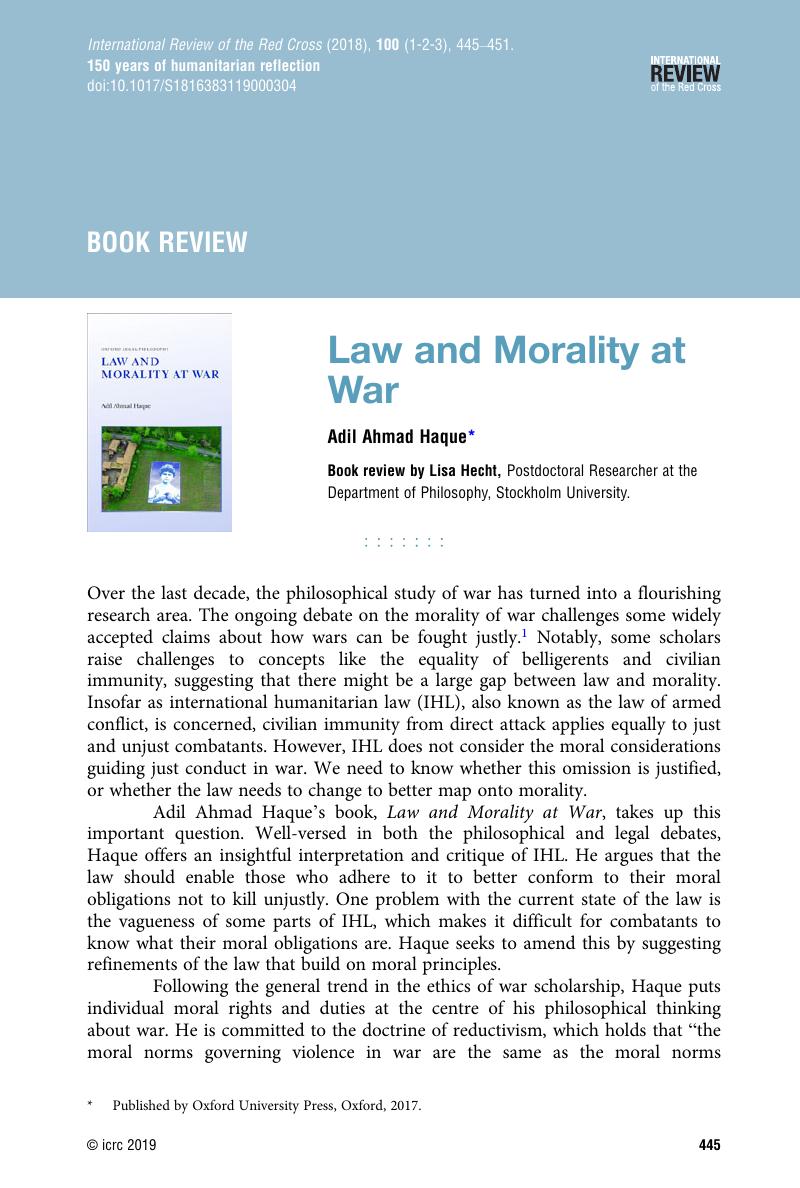No CrossRef data available.
Article contents
Law and Morality at War Adil Ahmad Haque *
Published online by Cambridge University Press: 09 September 2019
Abstract

- Type
- Books and articles
- Information
- International Review of the Red Cross , Volume 100 , Issue 907-909: 150 years of humanitarian reflection , April 2018 , pp. 445 - 451
- Copyright
- Copyright © icrc 2019
Footnotes
Published by Oxford University Press, Oxford, 2017.
References
1 Among them McMahan, Jeff, Killing in War, Oxford University Press, Oxford, 2008Google Scholar; Fabre, Cécile, Cosmopolitan War, Oxford University Press, Oxford, 2012CrossRefGoogle Scholar; Frowe, Helen, Defensive Killing, Oxford University Press, Oxford, 2014CrossRefGoogle Scholar.
2 Law and Morality at War, p. 9.
3 Protocol Additional (I) to the Geneva Conventions of 12 August 1949, and relating to the Protection of Victims of International Armed Conflicts 1125 UNTS 3, 8 June 1977 (entered into force 7 December 1978), Art. 43(2).
4 Melzer, Nils, Interpretative Guidance on the Notion of Direct Participation in Hostilities under International Law, ICRC, Geneva, 2009, p. 83Google Scholar.
5 Law and Morality at War, p. 44.
6 McMahan, for example, interprets international law as permitting combatants to kill irrespective of the side they fight for. He writes: “This idea [that no one does wrong, or acts impermissibly, merely by fighting in a war that turns out to be unjust] lies at the core of the reigning theory of the just war and also informs the international law of war.” J. McMahan, above note 1, p. 3.
7 Law and Morality at War, pp. 23–30.
8 Ibid., p. 136.
9 Ibid., p. 237.
10 Ibid., p. 251.
11 Ibid., p. 270.
12 Ibid., pp. 68, 268–269.
13 Ibid., p. 9.
14 Ibid., p. 68.
15 Ibid., p. 78.
16 Ibid., p. 77.
17 Ibid., p. 74.
18 Ibid., p. 75.
19 Parfit, Derek, Reasons and Persons, Oxford University Press, Oxford, 1984, p. 70Google Scholar.
20 For formulation and discussion of the NESS condition, see Wright, Richard W., “Causation in Tort Law”, California Law Review, Vol. 73, No. 6, 1985, p. 1790CrossRefGoogle Scholar.
21 For such proposals, see, for example, Kagan, Shelly, “Do I Make a Difference?”, Philosophy &Public Affairs, Vol. 39, No. 2, 2011Google Scholar; Nefsky, Julia, “How You Can Help, Without Making a Difference”, Philosophical Studies, Vol. 174, No. 11, 2017CrossRefGoogle Scholar; Barry, Christian and Øverland, Gerhard, “Individual Responsibility for Carbon Emissions: Is there Anything Wrong with Overdetermining Harm?”, in Moss, Jeremy (ed.), Climate Change and Justice, Cambridge University Press, Cambridge, 2015Google Scholar.




